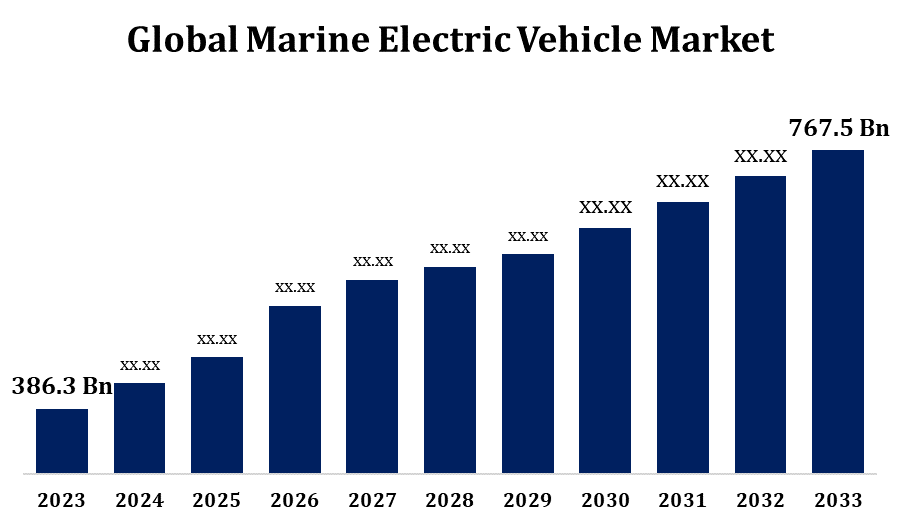Global Marine Electric Vehicle Market Size To Worth USD 767.5 Billion by 2033 | CAGR of 7.11%
Category: Aerospace & DefenseGlobal Marine Electric Vehicle Market Size To Worth USD 767.5 Billion by 2033
According to a research report published by Spherical Insights & Consulting, The Global Marine Electric Vehicle Market Size to grow from USD 386.3 billion in 2023 to USD 767.5 billion by 2033, at a Compound Annual Growth Rate (CAGR) of 7.11% during the forecast period.

Get more details on this report -
Browse 333 market data Tables and 47 Figures spread through 200 Pages and in-depth TOC on Global Marine Electric Vehicle Market Size, Share, and COVID-19 Impact Analysis, By Vehicle Type (Battery Electric, Plug-In Hybrid Electric, and Hybrid Electric), By Platform (On-water and Underwater), By Craft Application (Military, Leisure Tourist Surface Boat, Work Boat, Autonomous Underwater Vehicle (AUV), Personal Tourist Submarine and others), and By Region (North America, Europe, Asia-Pacific, Latin America, Middle East, and Africa), Analysis and Forecast 2023 - 2033." Get Detailed Report Description Here: https://www.sphericalinsights.com/press-release/magnesium-oxide-market
The marine electric vehicle market is experiencing substantial growth, driven by rising environmental awareness and the growing demand for sustainable maritime solutions. Electric propulsion systems are increasingly being adopted across both commercial and recreational vessels to lower carbon emissions and reduce operational expenses. Governments around the world are supporting this transition with regulations, subsidies, and investments in green technology. Furthermore, advancements in battery technology and improvements in electric powertrain efficiency are making electric vessels more feasible and cost-effective. The market is also seeing the rise of hybrid electric models, combining electric and conventional fuel sources to extend range. As the maritime industry continues its shift toward decarbonization, the demand for electric vehicles in this sector is expected to grow, transforming the future of maritime transport.Marine Electric Vehicle Market Value Chain Analysis
The marine electric vehicle market value chain involves several critical stages, beginning with the procurement of raw materials such as lithium, cobalt, and other vital components for battery production. Mining companies supply these materials to battery manufacturers, who develop advanced battery systems for electric propulsion. Electric propulsion system manufacturers then combine these batteries with electric motors and power electronics to create fully integrated powertrains for marine vessels. Vessel manufacturers incorporate these systems into various types of vessels, including commercial ships, yachts, and ferries. Once produced, the vessels are distributed through dealerships and service providers before being deployed for operation. The final stages include maintenance, repairs, and battery recycling. Throughout the entire process, regulatory bodies and government agencies play a key role in establishing standards and supporting sustainability efforts.
Marine Electric Vehicle Market Opportunity Analysis
The marine electric vehicle market offers substantial growth opportunities, fueled by the global transition to sustainable transportation and stricter environmental regulations. Rising fuel costs and advancements in battery technology are providing cost-effective solutions for both commercial and recreational marine operators. There are numerous opportunities for retrofitting existing vessels with electric or hybrid systems, helping industries meet carbon neutrality targets. Emerging markets, especially in the Asia-Pacific region, are adopting electric ferries and cargo vessels to curb emissions in crowded waterways. Furthermore, the growing demand for luxury electric yachts among eco-conscious consumers is boosting the recreational sector. Innovations in charging infrastructure, renewable energy integration, and energy storage solutions further enhance market potential. With increasing government incentives and subsidies, stakeholders can seize these opportunities to reshape the future of the maritime industry.
As concerns over the environmental impact of traditional fuel-powered vessels grow, stakeholders are increasingly turning to sustainable alternatives. Electric propulsion systems provide a cleaner solution, significantly cutting greenhouse gas emissions and reducing marine pollution. Governments globally are enforcing stricter environmental regulations and offering incentives to encourage the adoption of eco-friendly technologies, further driving market growth. The demand for electric ferries, cargo ships, and luxury yachts is rising as the maritime industry shifts toward greener practices. Advancements in battery technology, along with innovations in renewable energy integration, are improving the viability and attractiveness of electric vessels. This transition marks an important step toward a more sustainable and environmentally responsible marine industry.
The high upfront costs of electric propulsion systems and battery technology remain a significant obstacle, limiting widespread adoption, particularly among smaller operators. Current battery technologies face limitations in range and energy density, making them less suitable for long-distance maritime operations. The lack of a well-developed charging infrastructure in ports and waterways also presents operational difficulties. Furthermore, concerns over the availability and ethical sourcing of raw materials like lithium and cobalt for battery production raise environmental issues. Retrofitting existing vessels with electric systems can be both technically challenging and costly. Despite growing regulatory support, inconsistent global policies and standards can impede smooth market expansion, necessitating coordinated efforts to address these hurdles.
Insights by Vehicle Type
The battery segment accounted for the largest market share over the forecast period 2023 to 2033. The growth of the marine electric vehicle market is fueled by advancements in battery technology and the increasing adoption of electric propulsion systems. Lithium-ion batteries lead the segment due to their high energy density, lightweight structure, and long lifespan, making them ideal for marine use. Innovations in solid-state batteries and improvements in energy storage further enhance performance and extend range, addressing critical industry challenges. Governments and industry stakeholders are investing in R&D to create sustainable and efficient battery solutions, including recycling programs to minimize environmental impact. The rising demand for hybrid and fully electric vessels, such as ferries, yachts, and cargo ships, is driving the need for reliable battery systems. This trend positions the battery segment as a key driver of growth in the marine electric vehicle market.
Insights by Platform
The On-water segment accounted for the largest market share over the forecast period 2023 to 2033. This segment encompasses electric ferries, passenger boats, cargo vessels, and luxury yachts, which are gaining popularity due to their lower environmental impact and enhanced operational efficiency. Government initiatives promoting sustainable waterways and stringent emission standards are significant drivers of growth. Advancements in electric propulsion technology, combined with rising investments in renewable energy integration, further boost the segment's appeal. The growing trend of retrofitting traditional vessels with electric systems is also accelerating adoption. Additionally, the demand for electric recreational boats among environmentally-conscious consumers is on the rise. With ongoing improvements in battery technology and charging infrastructure, the on-water segment is set for continued growth, transforming the future of eco-friendly maritime transportation.
Insights by Craft Application
The military segment accounted for the largest market share over the forecast period 2023 to 2033. Electric and hybrid-electric vessels provide strategic benefits, such as reduced thermal and acoustic signatures, making them ideal for stealth operations. Governments are investing in the development of electric-powered patrol boats, submarines, and unmanned surface vehicles (USVs) to improve operational efficiency and meet environmental standards. Advancements in battery technology and energy storage systems support longer mission durations and enhanced reliability for military use. The shift toward electric propulsion is also driven by the need to reduce reliance on fossil fuels and meet global sustainability objectives. With defense budgets increasingly focused on green technologies, the military segment is expected to play a pivotal role in advancing marine electric vehicle technology.
Insights by Region

Get more details on this report -
North America is anticipated to dominate the Marine Electric Vehicle Market from 2023 to 2033. The United States and Canada are at the forefront of efforts to decarbonize waterways and reduce reliance on fossil fuels. Electric ferries, cargo ships, and recreational vessels are gaining momentum as both governments and private sectors invest in cleaner alternatives. Federal and state incentives, including tax credits and funding for green infrastructure, are facilitating the transition to electric propulsion systems. Moreover, advancements in battery technology and the establishment of charging infrastructure at key ports are improving the feasibility of electric vessels. North America's commitment to innovation and sustainability positions the region as a key influencer in the future development of the marine electric vehicle industry.
Asia Pacific is witnessing the fastest market growth between 2023 to 2033. China's efforts to reduce emissions in its vast inland waterways and port operations have driven significant adoption of electric propulsion systems. Japan and South Korea are investing in advanced battery technologies and hybrid-electric vessels to improve efficiency and cut pollution. In Southeast Asia, emerging economies are exploring electric solutions for short-distance transportation and tourism. Additionally, the region’s strong manufacturing base and cost-efficient production of electric components position Asia-Pacific as a key hub for the growth of the marine electric vehicle industry.
Recent Market Developments
- In September 2021, Corvus Energy and Sanmar Shipyards have signed a Memorandum of Understanding (MOU) to work together on developing hybrid and zero-emission tugboats.
Major players in the market
- Boesch Motorboote AG (Switzerland)
- Electrovaya (Canada)
- Corvus Energy (Canada)
- Duffy Electric Boat (US)
- Torqeedo GmBH (Germany)
- Triton Submarines (US)
- Ruban Bleu (France)
- Saft (France)
- Wärtsilä- (Finland)
- Boeing (US)
- Andaman Boatyard (Thailand)
Market Segmentation
- This study forecasts revenue at global, regional, and country levels from 2023 to 2033.
Marine Electric Vehicle Market, Vehicle Type Analysis
- Battery Electric
- Plug-In Hybrid Electric
- Hybrid Electric
Marine Electric Vehicle Market, Platform Analysis
- On-water
- Underwater
Marine Electric Vehicle Market, Craft Application Analysis
- Military
- Leisure Tourist Surface Boat
- Work Boat
- Autonomous Underwater Vehicle (AUV)
- Personal Tourist Submarine
- Others
Marine Electric Vehicle Market, Regional Analysis
- North America
- US
- Canada
- Mexico
- Europe
- Germany
- Uk
- France
- Italy
- Spain
- Russia
- Rest of Europe
- Asia Pacific
- China
- Japan
- India
- South Korea
- Australia
- Rest of Asia Pacific
- South America
- Brazil
- Argentina
- Rest of South America
- Middle East & Africa
- UAE
- Saudi Arabia
- Qatar
- South Africa
- Rest of the Middle East & Africa
About the Spherical Insights & Consulting
Spherical Insights & Consulting is a market research and consulting firm which provides actionable market research study, quantitative forecasting and trends analysis provides forward-looking insight especially designed for decision makers and aids ROI.
Which is catering to different industry such as financial sectors, industrial sectors, government organizations, universities, non-profits and corporations. The company's mission is to work with businesses to achieve business objectives and maintain strategic improvements.
CONTACT US:
For More Information on Your Target Market, Please Contact Us Below:
Phone: +1 303 800 4326 (the U.S.)
Phone: +91 90289 24100 (APAC)
Email: inquiry@sphericalinsights.com, sales@sphericalinsights.com
Contact Us: https://www.sphericalinsights.com/contact-us
Need help to buy this report?